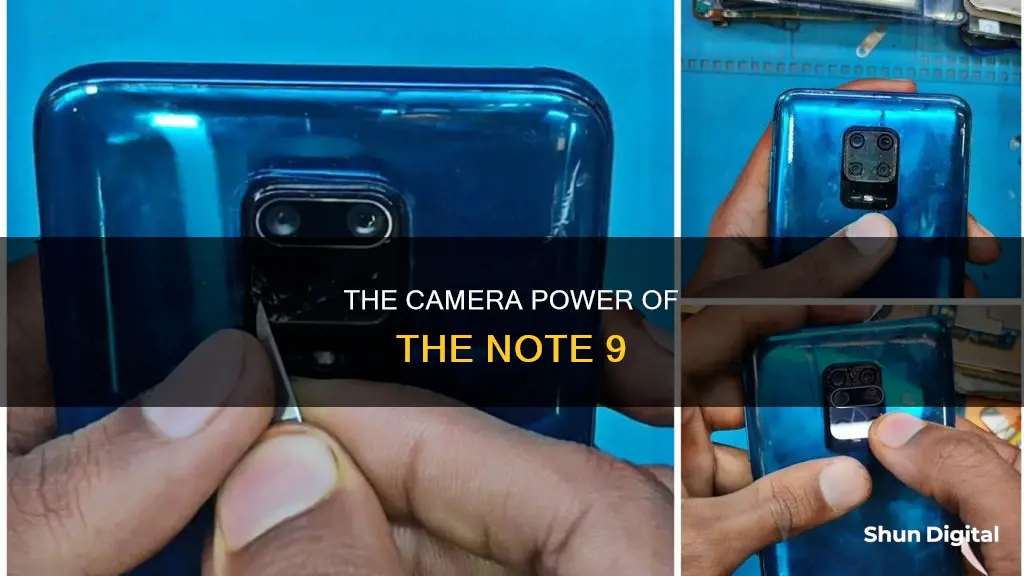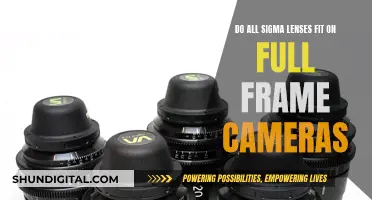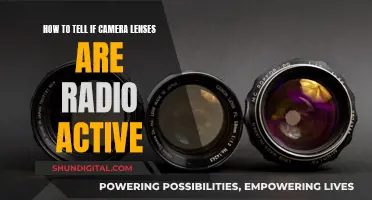
The Samsung Galaxy Note 9 is a large smartphone that uses either a Snapdragon 845 or Exynos 9810 octo-core processor. It has a dual-camera setup, with a wide-angle lens (26mm or 27mm equivalent focal length) and a telephoto lens (52mm equivalent focal length). Both lenses are optically stabilized and the camera has a unique dual-aperture system, with a variable aperture of f/1.5 and f/2.4 on the main shooter. The telephoto lens can function as a 2x optical zoom or enable Live Focus portraits. The front camera has an 8MP resolution and an equivalent focal length of 25mm.
| Characteristics | Values |
|---|---|
| Number of Cameras | 2 |
| Primary Camera Resolution | 12 MP |
| Primary Camera Aperture | f/1.5-2.4 |
| Primary Camera Focal Length | 26mm or 27mm |
| Primary Camera Autofocus | Dual-Pixel Phase Detection AF |
| Primary Camera Stabilization | Yes |
| Secondary Camera Resolution | 12 MP |
| Secondary Camera Aperture | f/2.4 |
| Secondary Camera Focal Length | 52mm |
| Secondary Camera Autofocus | Fixed-focus |
| Secondary Camera Stabilization | Yes |
| Front Camera Resolution | 8 MP |
| Front Camera Aperture | f/1.7 |
| Front Camera Focal Length | 25mm |
What You'll Learn
- The Note 9 has a dual-camera setup with a 12MP primary wide-angle lens and a 12MP ƒ/2.4 telephoto lens
- The camera has a dual-aperture system, with ƒ/1.5-ƒ/2.4 on the primary lens
- The camera software includes AI scene recognition that can identify 20 different types of scenes
- The Note 9 has a unique feature that warns of issues like a blinking eye, blurred photo or dirty lens
- The S-Pen can be used to take photos remotely

The Note 9 has a dual-camera setup with a 12MP primary wide-angle lens and a 12MP ƒ/2.4 telephoto lens
The Samsung Galaxy Note 9 is a high-end smartphone with a dual-camera setup, featuring a 12MP primary wide-angle lens and a 12MP ƒ/2.4 telephoto lens. The primary camera has a unique dual-aperture system, with a variable aperture of ƒ/1.5-ƒ/2.4, allowing for better performance in both daylight and low-light conditions. The telephoto lens has a 2x optical zoom capability and enables Live Focus portraits.
The camera system on the Note 9 is nearly identical to that of the Samsung Galaxy S9+, but with noticeable improvements in HDR image quality and low-light performance. The Note 9's camera is optically stabilized and has Dual-Pixel Phase Detection Autofocus. It also has a Scene Optimizer feature, which automatically selects the right colour balance for the subject, and a 'Flaw Detection' feature that warns users of issues such as a smudged lens or motion blur.
The Galaxy Note 9's camera is well-regarded for its image quality, with high levels of detail, low noise, neutral white balance, and accurate colour rendering. It performs exceptionally well in bright light conditions and has excellent dynamic range, capturing high-contrast scenes with deep shadows and bright highlights effectively. The camera's autofocus is also fast and accurate, and the dual-camera setup provides excellent versatility for both stills and videos.
Camera Lenses: Heavy Weights for the Perfect Shot
You may want to see also

The camera has a dual-aperture system, with ƒ/1.5-ƒ/2.4 on the primary lens
The Samsung Galaxy Note 9 has a dual-camera setup, with a primary lens that features a dual-aperture system. This means that the lens can switch between ƒ/1.5 and ƒ/2.4 apertures, which refers to how wide the lens opens to let in light. The wider the aperture, the more light is let in and the blurrier the background can be.
The dual-aperture system on the Note 9's primary lens offers increased flexibility in different lighting conditions. In bright lighting conditions, the lens can switch to the smaller ƒ/2.4 aperture, which lets in less light and can result in sharper images. On the other hand, in low-light conditions, the lens can switch to the larger ƒ/1.5 aperture to allow more light in, resulting in brighter and more detailed images.
The dual-aperture system on the primary lens of the Note 9 is a unique feature that enhances the camera's performance in various lighting conditions. It allows the camera to capture high-quality images with excellent dynamic range, exposure, and detail retention. The dual-aperture system, combined with Samsung's image processing and AI capabilities, contributes to the Note 9's reputation as one of the best smartphone cameras in low-light and daylight photography.
The dual-aperture system on the primary lens of the Note 9 is a notable feature that improves the camera's adaptability and image quality. It enables the camera to excel in a range of lighting environments, from low-light to bright daylight conditions, by adjusting the amount of light entering the lens. This, along with other camera features and specifications, makes the Note 9 a powerful device for mobile photography.
Unveiling the Secret Behind Your Phone's Camera Lens
You may want to see also

The camera software includes AI scene recognition that can identify 20 different types of scenes
The Samsung Galaxy Note 9's camera software includes AI scene recognition that can identify 20 different types of scenes. This feature is called Scene Optimizer and it actively tunes aspects like exposure, white balance, contrast and brightness to make sure the shot matches the ideal for each scene.
The 20 different types of scenes that the Note 9 can identify are: Food, portraits, flowers, indoor environments, animals, landscapes, greenery, trees, sky, mountains, beaches, sunrises and sunsets, watersides, street shots, night shots, waterfalls, snow, birds, strong backlighting and text.
The AI scene recognition feature can be turned off if the user prefers.
The Note 9 also has a feature called Flaw Detection, which calls out issues with photos and suggests ways to get around them. For example, it will warn the user if someone in the shot has blinked, if there is motion blur, or if the lens needs to be cleaned.
Capturing Distance: Camera Lenses' Visionary Power
You may want to see also

The Note 9 has a unique feature that warns of issues like a blinking eye, blurred photo or dirty lens
The Samsung Galaxy Note 9 is a high-end smartphone with a dual-camera setup, featuring a wide-angle camera with a 12MP sensor, f/1.5-2.4 dual-aperture lens, and dual-pixel autofocus. The second camera offers a 12MP sensor with a 2x "telephoto" lens and f/2.4 aperture. Both lenses are optically stabilized.
The Note 9 has a unique feature called Flaw Detection, which warns of common issues like a blinking eye, blurred photo or dirty lens. It also informs the user if HDR should be turned on. This feature is designed to help users take better photos by identifying potential issues immediately after a photo is taken, rather than after the fact when it may be too late to retake the shot.
The Flaw Detection feature is optional and can be turned off if users find it unnecessary or annoying. However, it can be especially useful when users are in a hurry and don't have time to check their photos for issues on the small screen of their phone.
In addition to Flaw Detection, the Note 9 also has a Scene Optimizer feature that uses AI to identify the type of scene being photographed and adjust settings like exposure, white balance, contrast and brightness to match the ideal for that scene. This feature can also be turned off if desired.
Overall, the Samsung Galaxy Note 9 is one of the best smartphone cameras on the market, especially for low-light photography, and its camera features, including Flaw Detection, make it a compelling choice for users who want to take high-quality photos with their phone.
Understanding Camera and Lens Lifespan by Shot Count
You may want to see also

The S-Pen can be used to take photos remotely
The S-Pen now has a "battery" (essentially a Super Capacitor) that charges when docked in the silo. Samsung claims 30 minutes of usage (or up to 200 clicks of the button) with only 40 seconds of charging.
The S-Pen's remote capabilities are not limited to the camera app. The button on the S-Pen can be tapped (hold, single or double) to do certain tasks, such as moving forwards or backwards in presentations. Third-party support is also provided for apps via an SDK.
Camera Lens Imperfections: Do Scratches and Marks Affect Quality?
You may want to see also
Frequently asked questions
The Note 9 has two lenses: a wide-angle lens and a telephoto lens.
The wide-angle lens has a focal length of 26mm-27mm, an aperture of f/1.5-2.4, and 12 megapixels.
The telephoto lens has a focal length of 52mm, an aperture of f/2.4, and 12 megapixels.
Some of the camera features of the Note 9 include Live Focus, Scene Optimizer, Flaw Detection, and remote capture using the S-Pen.







